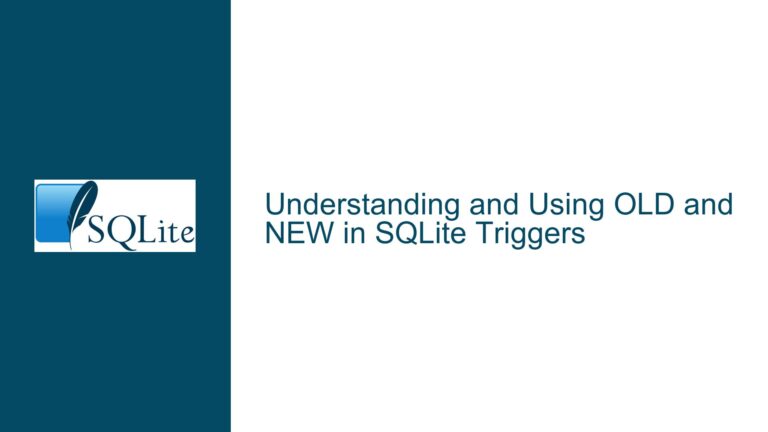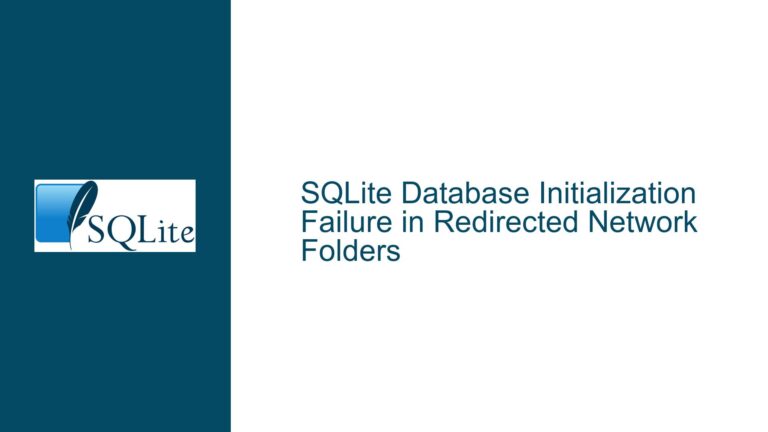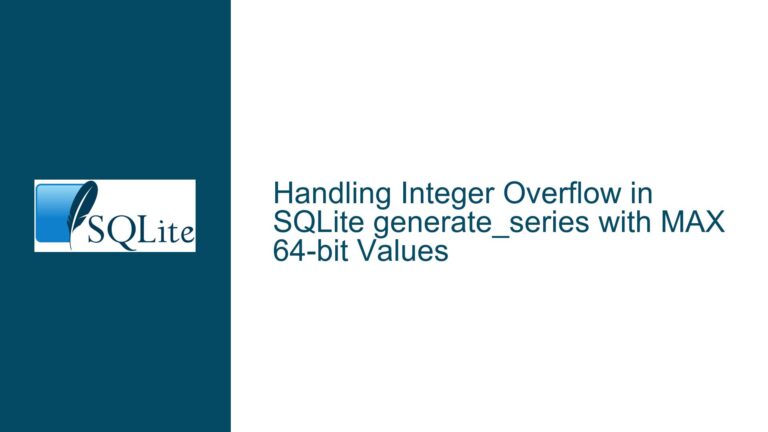SQLite .once Command Behavior with Pipes
Issue Overview: Immediate Execution of .once with Pipes
The core issue revolves around the behavior of the .once command in SQLite when used with pipes, particularly in interactive sessions. The .once command is designed to send the output of the next SQL command to a specified file or pipe. However, when a pipe is used (e.g., .once |less), the external command (in this case, less) is executed immediately, rather than waiting for the SQL command to be executed and its output to be generated. This immediate execution can be problematic in interactive sessions where the user expects to input a SQL command before the external command is invoked.
The expectation was that SQLite would wait for the user to input a SQL command, execute that command, and then pipe the output to the external command. Instead, the external command is launched right away, which can interfere with the user’s ability to input the SQL command, especially if the external command (like less) takes over the terminal.
Possible Causes: Misalignment Between User Expectations and SQLite’s Implementation
The immediate execution of the external command when using .once with pipes stems from how SQLite handles the .once meta-command internally. When .once is used with a pipe, SQLite creates a new process for the external command and establishes a pipe between the SQLite shell and this new process. The SQLite shell does not relinquish control of the standard input (stdin) to the external command, but it does start the external command immediately, regardless of whether there is any output to send to it yet.
This behavior is consistent with how pipes generally work in Unix-like systems: the process on the right side of the pipe (in this case, less) is started immediately, and it begins reading from its standard input as soon as it is launched. However, this behavior can be counterintuitive in an interactive SQLite session, where the user might expect the external command to be invoked only after the SQL command has been executed and its output is ready to be piped.
Another factor contributing to the confusion is the distinction between the .once and .output commands. While .once is intended to send the output of the next SQL command to a file or pipe, .output is used to redirect all subsequent output to a file or pipe until it is explicitly turned off. The behavior of .once with pipes might be more intuitive if it were designed to wait for the SQL command to be executed before starting the external command, but this would require significant changes to the SQLite shell’s input handling and process management.
Troubleshooting Steps, Solutions & Fixes: Workarounds and Best Practices
Given the current behavior of the .once command with pipes, there are several workarounds and best practices that can be employed to achieve the desired outcome without running into the issue of immediate execution.
1. Using Temporary Files for Output Redirection
One effective workaround is to use a temporary file to capture the output of the SQL command and then invoke the external command on that file. This approach avoids the immediate execution of the external command and allows the user to input the SQL command without interference.
.once tempfile.txt
SELECT * FROM my_table;
.system less tempfile.txt
In this example, the output of the SELECT statement is first redirected to tempfile.txt. After the SQL command is executed, the .system command is used to invoke less on the temporary file. This ensures that less is only started after the SQL command has been executed and its output has been written to the file.
2. Using Scripts for Non-Interactive Execution
Another approach is to use SQLite in a non-interactive mode, where the SQL commands are provided as part of a script. This method is particularly useful when the SQL commands are known in advance and do not require user input during execution.
sqlite3 mydatabase.db <<EOSQL
.once |less
SELECT * FROM my_table;
EOSQL
In this example, the SQL commands are provided as a here-document (<<EOSQL), and the .once |less command is used to pipe the output of the SELECT statement to less. Since the SQL commands are provided upfront, the immediate execution of less is not an issue, and the output is displayed as expected.
3. Modifying the SQLite Shell for Delayed Execution
For advanced users who are comfortable with modifying the SQLite source code, it is possible to alter the behavior of the .once command to delay the execution of the external command until after the SQL command has been executed. This would involve modifying the SQLite shell’s input handling logic to queue up the SQL commands and only start the external command once the output is ready.
However, this approach is not recommended for most users, as it requires a deep understanding of the SQLite codebase and could introduce unintended side effects. Additionally, any custom modifications would need to be reapplied whenever the SQLite shell is updated.
4. Clarifying Documentation and User Expectations
While not a technical solution, improving the documentation around the .once command and its behavior with pipes can help set the right expectations for users. The documentation could explicitly state that the external command is started immediately when .once is used with a pipe, and provide examples of workarounds for interactive sessions.
For example, the documentation could include a note like:
"When using
.oncewith a pipe (e.g.,.once |less), the specified command is started immediately. In interactive sessions, this may interfere with the ability to input SQL commands. Consider using temporary files or non-interactive scripts as workarounds."
This clarification would help users understand the behavior and choose the appropriate approach for their use case.
5. Alternative Tools and Approaches
In some cases, it may be more practical to use alternative tools or approaches that better align with the desired workflow. For example, instead of using .once |less in an interactive SQLite session, users could execute their SQL commands first and then manually pipe the output to less from the command line.
sqlite3 mydatabase.db "SELECT * FROM my_table;" | less
This approach avoids the issue altogether by separating the SQL command execution from the output redirection, giving the user full control over when the external command is invoked.
Conclusion
The immediate execution of external commands when using .once with pipes in SQLite can be a source of confusion, particularly in interactive sessions. However, by understanding the underlying behavior and employing appropriate workarounds, users can achieve their desired outcomes without running into issues. Whether through the use of temporary files, non-interactive scripts, or alternative tools, there are multiple ways to work around the immediate execution behavior and ensure a smooth workflow. Additionally, improving the documentation around this behavior can help set the right expectations for users and prevent confusion in the future.






